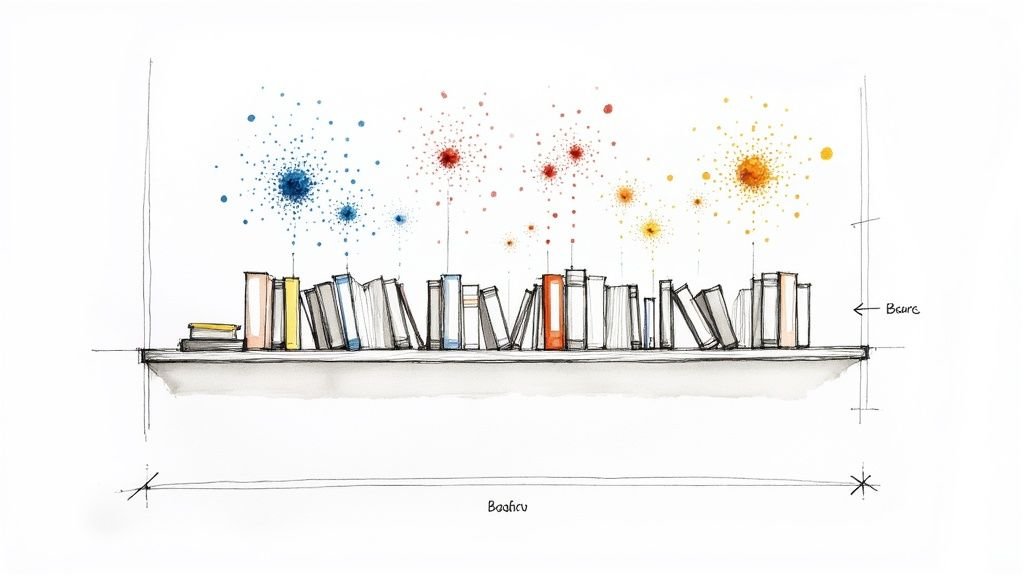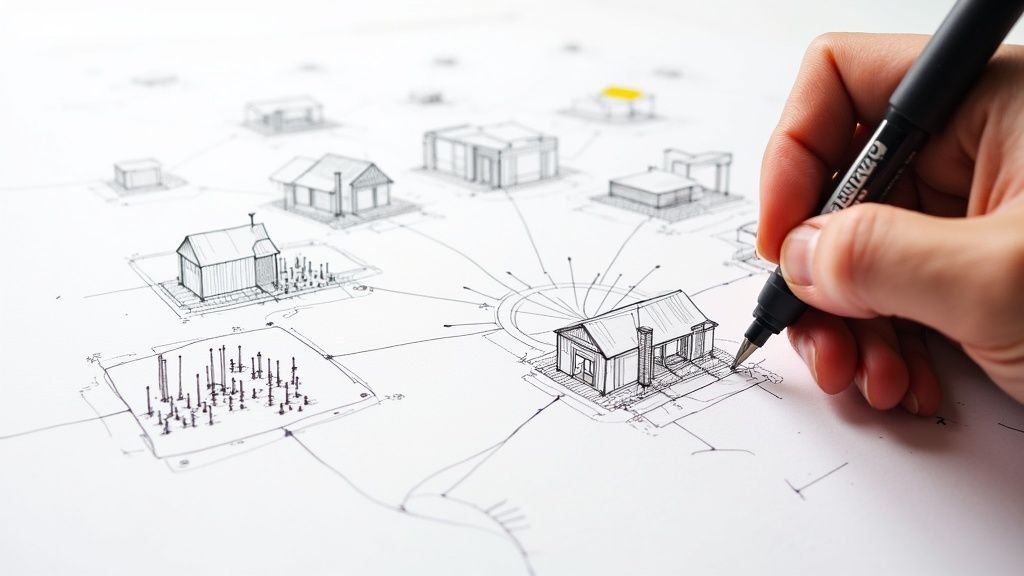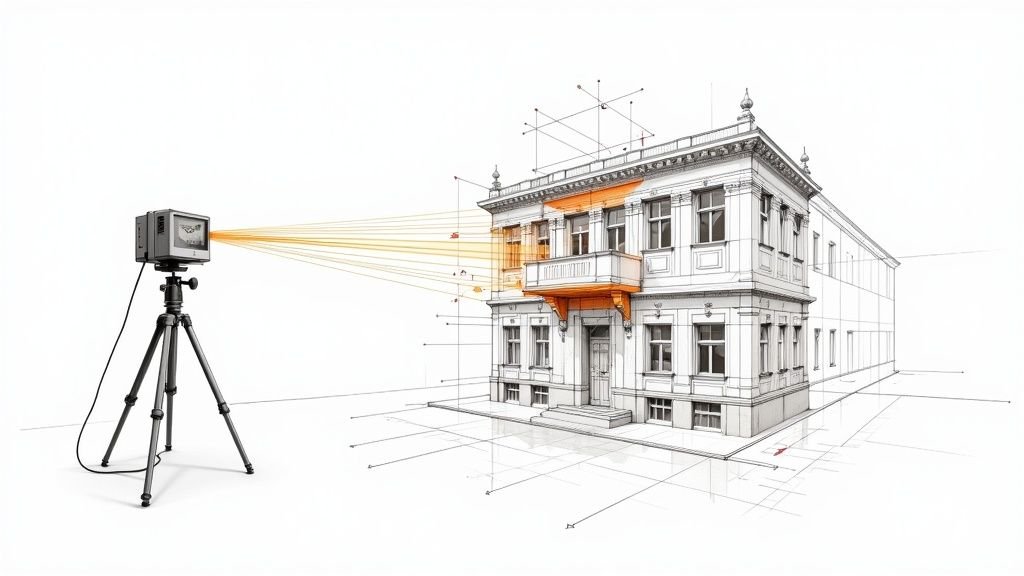Top Challenges in Scan to BIM for Large Point Clouds
Top Challenges in Scan to BIM for Large Point Clouds
Scan to BIM is transforming how architects, engineers, and construction teams model existing structures. But working with large point clouds – datasets with billions of data points – comes with major challenges. These include handling massive file sizes, ensuring data accuracy, and managing software compatibility. Environmental factors, missing data, and strict U.S. accuracy standards add further complexity. High costs for equipment, software, and skilled labor also strain resources, making outsourcing a practical solution for many firms. By optimizing workflows and leveraging advanced tools, teams can overcome these hurdles and deliver precise BIM models efficiently.
Key challenges include:
- Data Size: Point clouds can reach terabytes, requiring robust storage and processing systems.
- Accuracy Issues: Noise, occlusions, and environmental conditions can impact scan quality.
- Software Compatibility: Converting between file formats risks data loss and inefficiencies.
- Cost and Expertise: High costs for equipment, software, and skilled professionals.
Solution Highlights:
- Divide datasets into smaller sections for easier processing.
- Use cloud-based tools for faster computation.
- Outsource to experts to reduce costs and ensure compliance with U.S. standards.
Efficient Scan to BIM workflows require balancing technology, expertise, and cost-effective strategies.
Faster Industrial As-Builts: A Case Study on Scan to BIM for Large, Complex Plants
Processing Large Point Cloud Datasets
After capturing large point cloud data, the next hurdle is processing it – a task that comes with its own set of challenges. One of the most pressing issues in Scan to BIM workflows is managing the sheer size of these datasets.
Data Size and Storage Issues
Point cloud datasets can be massive, often ranging from gigabytes to terabytes and containing billions of individual data points. This enormous size puts a significant strain on storage systems, requiring advanced solutions to handle the data efficiently. On top of that, maintaining data quality and accuracy during processing adds another layer of complexity to the workflow.
Data Quality and Accuracy Issues
Handling massive point cloud datasets is one thing, but ensuring the quality of that data is an entirely different challenge. The reliability of your final BIM model hinges on the precision of the original scan data. Unfortunately, several factors during the scanning process can undermine this accuracy.
Noise and Environmental Problems
Environmental conditions can wreak havoc on scanner performance. Bright sunlight, shadows, and harsh weather can reduce the precision of scans. Reflective surfaces – like glass windows, polished floors, or metal fixtures – often cause scanners to misread or scatter points, resulting in data that doesn’t accurately reflect the building’s geometry.
Then there’s the issue of ambient particles and movement, which introduce noise that must later be filtered out during processing. Even temperature changes can throw off scanner calibration, as most laser scanners work best in temperatures between 32°F and 104°F (0°C to 40°C).
These environmental and equipment-related hurdles directly affect data completeness, which we’ll dive into next.
Missing or Incomplete Data
Occlusions are a persistent headache in point cloud data collection. Complex building layouts, furniture, equipment, and structural elements can block the scanner’s line of sight, leaving critical areas unscanned. This is why careful planning around scanner placement and the number of scan stations is essential to reduce blind spots.
Another common issue is misregistration between scans, which can lead to duplicate geometry or gaps in the data. This problem becomes even more challenging in large-scale projects where dozens of scans need to be stitched together accurately.
And let’s not forget the limitations of laser scanning itself. Underground utilities, hidden structural components, and areas behind walls remain invisible, leaving BIM models incomplete when it comes to MEP systems or structural details. These gaps can compromise the overall accuracy of the model, especially when strict US standards come into play.
US Accuracy Standards
Maintaining data quality is even more critical when trying to meet the rigorous accuracy standards set in the United States. BIM models here must adhere to specific Level of Development (LOD) requirements. For example, LOD 300 demands dimensional tolerances within ±1/4 inch for structural elements. Additionally, organizations like the American Institute of Architects (AIA) and the Associated General Contractors of America (AGC) require that point cloud-derived BIM models maintain positional accuracy within ±1/2 inch for overall building dimensions.
Standards like ASTM E57 outline guidelines for handling 3D imaging data, emphasizing the importance of maintaining data quality throughout the scanning and processing workflow. Federal projects often impose even stricter requirements. For instance, some General Services Administration (GSA) projects mandate accuracy within ±1/8 inch for critical dimensions.
These challenges become even more pronounced when working with older buildings. In such cases, deviations from modern tolerances can make the Scan to BIM process more complex. While point clouds can capture existing conditions, including imperfections, translating this into a compliant BIM model requires careful judgment to decide which deviations to model and which to standardize.
File Format and Software Compatibility
Handling large point cloud datasets in Scan to BIM projects often involves juggling various file formats across different software platforms, which can lead to inefficiencies and delays.
File Formats and Compatibility Challenges
Point cloud data comes in multiple file formats, and integrating it into BIM workflows often requires converting these files. This conversion process can complicate operations, forcing teams to use additional tools or purchase extra licenses just to ensure compatibility between platforms.
Data Loss During File Conversion
Reducing file sizes through downsampling can unintentionally strip away critical details, such as fine architectural features or metadata like color and intensity. These losses can compromise the accuracy of the data. Even minor errors introduced during file conversions can accumulate, potentially affecting the dimensional precision of the resulting BIM model. These challenges make it clear how important standardized data exchange is for maintaining accuracy.
The Need for Platform Standardization
A universal standard for point cloud data exchange is still missing, creating hurdles for stakeholders like design teams and construction managers who often work within software ecosystems restricted to specific file formats. While progress is being made toward establishing standardized protocols, many organizations are still forced to run parallel workflows to balance project efficiency with regulatory requirements. Aligning file formats with processing workflows is key to addressing these limitations.
At BIM Heroes, we tackle these compatibility issues head-on by combining advanced cloud-based tools with expert workflows. This approach ensures that point cloud data is seamlessly and accurately integrated into the BIM process.
sbb-itb-0af4724
Cost and Resource Limitations
For many AEC firms, implementing Scan to BIM workflows for large-scale point cloud projects can be a significant financial and logistical hurdle. These challenges go beyond just the upfront costs of equipment, impacting project timelines and overall profitability. Let’s break down the key cost drivers, labor issues, and the potential advantages of outsourcing.
Equipment and Software Costs
Investing in high-end laser scanning equipment is no small expense. On top of that, firms face ongoing costs for licenses tied to advanced point cloud processing and BIM modeling software. Add to this the need for high-performance workstations, cloud computing services, and storage solutions capable of handling massive datasets, and the total expenditure quickly escalates.
Skilled Professional Shortage
Finding skilled professionals in point cloud processing, 3D modeling, and BIM software is another major roadblock. In the U.S., this specialized expertise is in short supply, driving up salaries and putting smaller firms under financial strain. Training existing staff to master Scan to BIM workflows is another option, but it takes time – time that could delay project delivery and stretch resources thin.
Outsourcing as a Cost Solution
Outsourcing point cloud to BIM conversion offers a practical way to navigate these challenges. By outsourcing, firms can sidestep the hefty upfront costs of purchasing equipment, software, and hiring full-time specialists. Instead, they pay only for the work they need, turning fixed costs into flexible, project-based expenses.
BIM Heroes steps in with a solution tailored to these needs. Their team of experienced BIM professionals uses cutting-edge technology and adheres to global building standards to deliver top-notch results. By offering flexible pricing plans that align with specific project requirements, BIM Heroes enables firms to stay competitive without the need for costly in-house infrastructure. This approach helps AEC firms manage their resources more effectively while ensuring high-quality outcomes.
Solutions and Best Practices
Successfully managing large point cloud datasets in Scan to BIM workflows requires a thoughtful approach that blends streamlined workflows, cutting-edge technology, and adherence to strict industry standards. The challenges of data size, quality, and compatibility can be tackled effectively with a combination of these strategies.
Workflow Optimization for Large Point Clouds
When dealing with massive point cloud datasets, breaking them into smaller, manageable chunks can make a world of difference. Dividing datasets by zones or floors helps reduce processing strain and allows multiple team members to work on different sections simultaneously, speeding up the overall workflow.
Cleaning and filtering the data early in the process is another game-changer. Removing unnecessary elements like vegetation, temporary structures, or excessive noise ensures the dataset remains accurate without being bloated. Defining clear level of detail (LOD) requirements from the start also prevents over-modeling, keeping processing times in check.
Cloud-based processing solutions can further lighten the load by distributing computational tasks across multiple servers. This often results in faster processing compared to traditional desktop systems. Adding automated quality control checkpoints – such as clash detection, dimensional checks, and completeness reviews – helps catch issues early and prevents them from escalating into bigger problems later.
Advanced Technology and Expert Teams
Processing large point clouds is no small feat, requiring both advanced technology and skilled professionals. Machine learning is becoming a key player in automating tasks like object recognition and classification, which reduces the need for time-consuming manual modeling of structural elements and MEP systems.
While having powerful computing systems is crucial, not every firm can justify the hefty investment. Outsourcing to specialized teams often becomes a practical solution. For example, BIM Heroes offers dedicated teams that handle large-scale point cloud projects with efficiency and precision. Their experts rely on enterprise-grade software and high-performance computing resources to process complex datasets while ensuring accurate construction documentation. These professionals can also identify potential issues early, recommend workflow improvements, and deliver BIM models that meet both technical and practical needs.
US Standards Compliance
Maintaining compliance with US building codes and accuracy standards is a critical part of any Scan to BIM project. Adhering to established guidelines, such as ASTM E57 for 3D imaging data exchange, ensures data integrity during conversion, minimizes the risk of data loss, and supports compatibility across various software platforms.
Quality assurance measures should include verifying BIM model dimensions against known benchmarks and control points to ensure critical building elements meet tolerance requirements. Thorough documentation of these processes is vital for project approvals and liability protection.
At BIM Heroes, US standards compliance is embedded into every step of their Point Cloud to BIM conversion workflow. Their quality control processes include multi-level reviews that check for dimensional accuracy, code adherence, and proper formatting of deliverables based on client needs and industry standards. This methodical approach ensures the final results align with the stringent demands of US construction projects while remaining flexible enough to meet specific client requirements.
Conclusion
Transforming large point clouds into precise BIM models is no small feat. The process comes with its fair share of challenges, but with the right mix of technology, expertise, and careful planning, these hurdles can be overcome.
A critical factor for success is streamlining workflows – breaking down massive datasets into manageable pieces while safeguarding data accuracy throughout the conversion. Tools like machine learning and cloud-based processing are reshaping how teams tackle complex point cloud projects, cutting down manual labor and boosting precision. That said, technology alone isn’t enough; skilled professionals are essential for delivering top-notch results.
Financial and resource limitations also add to the complexity. Investing in specialized hardware, software, and trained staff can strain budgets. This is where outsourcing to experts like BIM Heroes becomes a smart move. Their dedicated teams bring advanced processing tools and in-depth knowledge of U.S. building codes to the table, ensuring projects meet both technical and regulatory standards. Outsourcing allows firms to achieve professional-grade results without the burden of significant overhead, freeing them to focus on their core strengths.
In today’s competitive construction landscape, mastering large-scale Scan to BIM workflows is becoming essential. Firms that embrace optimized processes, adopt advanced technologies, and collaborate with skilled professionals are better equipped to tackle the intricate demands of modern building projects. Success lies in striking the right balance between cutting-edge tools, hands-on expertise, and unwavering quality.
FAQs
How can large point cloud data be effectively managed in Scan to BIM projects?
Managing large point cloud data in Scan to BIM projects calls for a mix of smart strategies and the right tools. Start by opting for compact file formats and employing data compression techniques to shrink file sizes while keeping essential details intact. Pre-processing steps like denoising and filtering are also vital – they remove unnecessary data before you bring it into your BIM software, making the process smoother.
For tackling dense datasets, cloud-based processing can be a game-changer. It shifts the heavy lifting from your local hardware to powerful external servers, saving both time and resources. Pair that with scalable storage options – whether it’s external drives or cloud storage – and you’ll have plenty of room to manage and archive large files without sacrificing accessibility. These approaches not only simplify workflows but also boost processing efficiency and help sidestep hardware bottlenecks.
How can firms maintain accurate and high-quality data when faced with environmental and equipment challenges during Scan to BIM processes?
To ensure accurate and high-quality data, firms need to pay attention to external conditions like lighting, vibrations, and temperature during scanning, as these factors can greatly influence results. Using high-resolution equipment specifically designed for precise data capture is equally important to address potential challenges.
Establishing solid workflows is another key step. Processes such as regular data validation, noise filtering, and proper registration help catch and fix errors early in the process. On top of that, advanced tools like AI-driven quality assurance systems can play a big role. These tools can spot inconsistencies caused by environmental conditions or equipment issues, ensuring the point cloud data is dependable for creating detailed and precise BIM models.
What are the advantages of outsourcing Scan to BIM tasks, and how does it ensure compliance with U.S. standards?
Outsourcing Scan to BIM tasks offers several clear benefits, particularly when it comes to improving precision and productivity in converting massive point cloud datasets into detailed 3D models. This process ensures alignment with U.S. construction and architectural standards, which prioritize meticulous detail and accuracy.
By leveraging the expertise of specialized professionals, firms can achieve quicker project turnarounds, thorough quality assurance, and access to cutting-edge tools. This not only meets the stringent accuracy standards required in the U.S. but also allows internal teams to concentrate on key project goals without compromising on quality.









